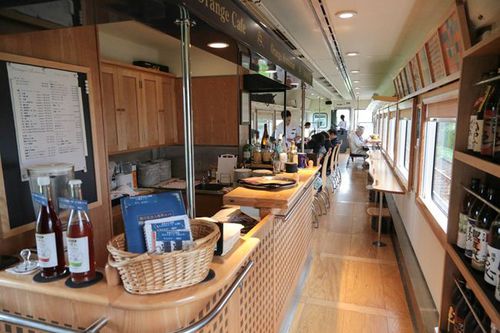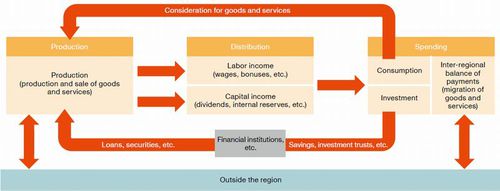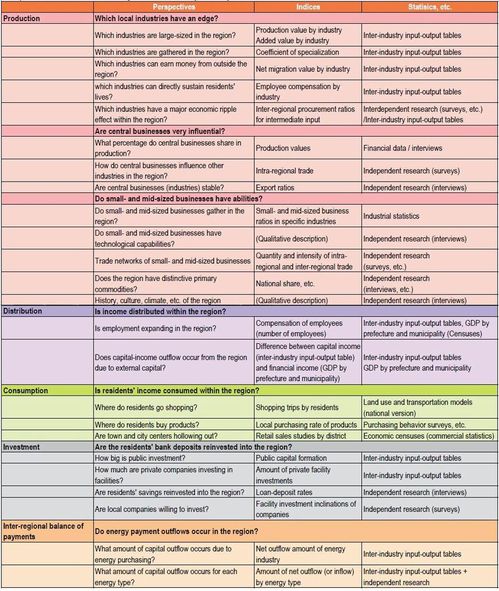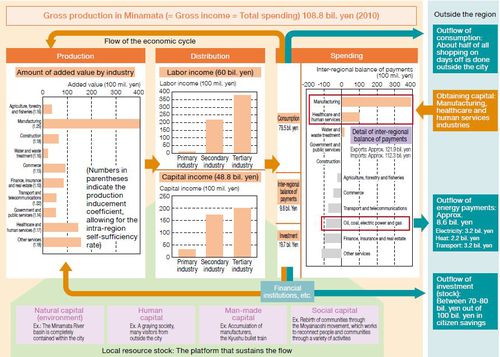September 11, 2016
Community Building through Local Money Circulation Analysis -- The Case of Minamata, Japan
Keywords: Civil Society / Local Issues Money Newsletter
JFS Newsletter No.168 (August 2016)

Orange Restaurant Express: Sightseeing trains on which passengers can enjoy
scenery and dishes that use locally produced ingredients along the railway line.
Photo by Norio NAKAYAMA Some Rights Reserved.
Overcoming a Shrinking Local Economy
The ability to make local economies more sustainable is key to promoting local people's sustainability, wellbeing and resilience. From this perspective, Japan's Ministry of the Environment has developed a tool which enables people to analyze their local economy. This article introduces this concept as presented in the Annual Report on the Environment, the Sound Material-Cycle Society, and Biodiversity in Japan 2015, analyzing the case of Minamata in Kumamoto Prefecture, Japan.
Japan is promoting regional revitalization with the goal of forming local communities that offer hope for the future of their residents by helping them lead affluent lives with enhanced individuality. Combating regional economic contraction is central to this effort. To stop economies from shrinking in local areas and to build communities with diversity and attractiveness are not only important for rural areas but essential to Japan as a whole for enjoying well-being in a mid-to-long-term perspective. This article introduces a "Regional Economic Cycle Analysis" that enables people to identify a community's strengths and issues with regard to greenhouse gas emissions, with the goal of revitalizing regional economies through the use of local resources.

Example of a Regional Economic Cycyle (Click to view large image)
Source: Ministry of the Environment
The major feature of this analysis is to demonstrate the issues to be addressed in the local economic flow within the region and between regions, by extending the perspective from production alone to distribution and spending as well, including consumption, investment and inter-regional balances of payments. In production, distribution, spending, investment and inter-regional balances of payments, the analysis allows money drainage from the region to be identified and local economic circulation issues to be understood. Moreover, by understanding which industries can acquire money outside the region and their size, and the inter-regional procurement ratio of intermediate input such as parts and raw materials that are necessary for the production of final consumption goods, the strengths of the regional economic cycle can be clarified quantitatively.
To expand the amount of money circulating within a region's economy, it is essential to utilize local resources sustainably, to earn more money outside the region and to decrease the draining of money from the region. To earn money outside the region, it is also essential to differentiate local products and services from those outside the region and create field-oriented businesses by utilizing regional resources. Moreover, creating local businesses in a way that elicits demand outside the region can stimulate demand within the region, too.
Methods of Analysis
In this analysis, the region's economic activity is divided into five parts: production, distribution, consumption, investment and inter-regional balance of payments (difference between total revenue and total spending in the region). Various statistics are necessary for analyzing the local money cycles in each part, the most important being GDP by prefecture and municipality and inter-industry input-output tables by municipality, which provide a detailed understanding of the flow of goods and services into and out of the region. Interviews and surveys can supplement these statistics when they fail to provide a complete understanding.

Perspectives and Indices of the Regional Economic Cycle Analysis
(Click to view large image)
Source: Ministry of the Environment
Translation prepared by JFS
Identifying Issues through Regional Economic Cycle Analysis -- Case Study of Minamata
Although Minamata in Kumamoto Prefecture has made progress in its environmental efforts, its local economy has been battered by the impacts of a falling and progressively aging population, so the city sought to address the issue of how to revive its economy through environmental policies. Using calculations of civic economic benefits and a survey of all businesses in the city, Minamata prepared an inter-industry table for the city along with a variety of other statistics. Using these data, it conducted a "health check" of the local economy based on the Regional Economic Cycle Analysis approach, which yielded the results shown below and highlighted certain issues.

Overview of Minamata's Regional Economic Cycle (Click to view large image)
Note: 100 mil. yen is about US$952,000
Source: Ministry of the Environment
(Viewpoint 1) Production: Which local industries have an edge?
Industries in Minamata capable of attracting funding from outside the region included manufacturing, such as chemical manufacturers, as well as the healthcare and human services industries (center of secondary medical district). Of the city's domestic production value of 212.3 billion yen (about US$2.02 billion) in 2010, one central business group in the city (Company A) accounted for about 57.6 billion yen (about US$549 million, 27%), followed by the healthcare, health, social security and nursing care sectors that accounted for 25.7 billion yen (about US$245 million, 12%). As for the value-added amount, Company A accounted for 24.8 billion yen (about US$236 million, 23%) and the healthcare and human services industries accounted for 14.39 billion yen (about US$ 137 million, 15%). Considering that Japan's manufacturing industry accounted for 19.6% of its entire gross domestic product (GDP) in 2010, Company A accounted for a significant portion of Minamata City's value-added amount.
Taking into account the perspective of regional balances in Viewpoint 5, the industry making great profits outside of Minamata was also represented by Company A, with 53.6 billion yen (about US$510 million), followed by the healthcare industry, with 10 billion yen (about US$95.24 million). Beyond that, other manufacturing industries such as electric machines, pulp/paper/wooden products and electronic parts had competitive companies, each with sales of 4.5-5.7 billion yen (about US$42.86-54.29 million) outside of the city. At the same time, one company in the city (Company A) did business with other companies in Minamata in the field of capital investment, but procured nearly 100 percent of its raw materials from outside the city. In other words, expansion of Company A's production in the city was limited to its existing equipment, which also limited the economic ripple effect within the city.
(Viewpoint 2) Distribution: Do the earnings of local companies translate into income for local residents?
In fiscal 2010, local gross income totaled 108.8 billion yen (about US$1.036 billion), of which labor income represented 60 billion yen (about US$571 million), or about 55 percent. Of that, 10.74 billion yen (about US$102 million) was related to the healthcare and nursing care industry, while the share related to Company A represented 10.67 billion yen (about US$102 million). Company A's share of the total was lower than expected from the standpoint of local citizens, and this was attributed to changes in its business model and other factors that left it with only about one-fifth of the number of employees it had at its peak, thus accounting for a decreased proportion of labor income of the city overall.
(Viewpoint 3) Consumption: Is the income of local residents being consumed locally?
From data on the movement of residents and where Minamata residents went for personal business such as shopping, it was found that nearly half of the residents went shopping outside the city on their days off. In addition, while retail sales fell by nearly 5 billion yen (about US$47.62 million) in the 10-year period from 1997 to 2007, roadside commercial districts in adjacent cities saw retail sales increase by 8.5 billion yen (about US$80.95 million) over the same period. This indicates an outflow of capital from income within the city via consumption in areas outside the city.
(Viewpoint 4) Investment: Are residents' savings being reinvested in the local community?
An analysis of savings deposited at financial institutions in Minamata, totaling more than 100 billion yen (about US$952.4 million) revealed that only 20 to 30 percent of the amount was being reinvested in the city, while the remainder was used to purchase government bonds and for lending outside the city. Underlying factors are thought to include the lack of both financial institutions' stance toward financing and corporations' inclination to invest in plants and equipment. Minamata is a so-called "business castletown" for Company A. While there are vertical business relationships between Company A and its subcontractors with high-level technology, there is little horizontal cooperation among these subcontractors, which discourages the creation of new businesses.
(Viewpoint 5) Interregional balance of payments: Is there an outflow of funds to other regions?
According to Viewpoint 1, while the manufacturing and healthcare industries brought in capital from outside the city, the service and commercial industries were unable to meet local demand, and capital in these industries was flowing outside the city. Generally, business services, real estate, telecommunications, electric power, gas and heat supply business and commerce are necessary for all industries. In Minamata, however, although the ratio of business services to meet all industries' demand was relatively high, net exports of these business services were in deficit because many companies used services from outside the city. In addition, due to energy-related payments for electricity, gas and petroleum products such as gasoline and coal-based products, approximately 8 percent of total regional production, equivalent to about 8.6 billion yen (about US$ 81.9 million), was also going to payments outside the city.
Minamata's Initiatives for Environmental Town Building Using Regional Economic Cycle Analysis
In Minamata, the citizens and some experts have been discussing local revitalization through "environmental town building" using the Regional Economic Cycle Analysis, and have been promoting concrete projects to expand the regional economic cycle. Some of these initiatives are introduced below.
As a measurement of industrial development to stimulate consumption and demand both inside and outside the region, the city has promoted low-carbon tourism using public transportation. It has started operating sightseeing trains on which passengers can enjoy scenery and dishes that use locally produced ingredients along the railway line. In addition to development of low-carbon travel services, it also provides facilities featuring environmentally friendly spaces under the concept of "spiritually affluent public spaces." Such efforts have led to a certain amount of increase in tourism revenues.
To stem the outflow of energy costs, a renewable energy project was proposed at a civic participation round-table meeting. Photovoltaic generation and biomass power generation business projects are promoted. Biomass power generation business in particular is expected to create jobs in local forestry business and power plant operation. It may be possible to sell energy from renewable sources to other cities.
Moreover, to increase the amount of re-investment within the city, a financing system for activation of environmental investment has been considered. For financing of environmental investment by local small- and medium-sized businesses, the city has established a system to subsidize interest for three years and provide the total amount of guarantee money to credit guarantee corporations. As a result, the amount of loans for introducing high-efficiency lighting and air conditioning and facilities related to recycling and renewable energy has been increasing.
From Chapter 3 Regional efforts -- building sustainability in the Annual Report on the Environment, the Sound Material-Cycle Society, and Biodiversity in Japan 2015
https://www.env.go.jp/en/wpaper/2015/index.html
https://www.env.go.jp/en/wpaper/2015/pdf/05.pdf
Edited by Junko Edahiro
Related
"JFS Newsletter"
- 'Good Companies in Japan' (Article No.4): 'Eightfold Satisfaction' Management for Everyone's Happiness
- "Nai-Mono-Wa-Nai": Ama Town's Concept of Sufficiency and Message to the World
- 'Yumekaze' Wind Turbine Project Connects Metro Consumers and Regional Producers: Seikatsu Club Consumers' Co-operative
- Shaping Japan's Energy toward 2050 Participating in the Round Table for Studying Energy Situations
- 'Good Companies in Japan' (Article No.3): Seeking Ways to Develop Societal Contribution along with Core Businesses


